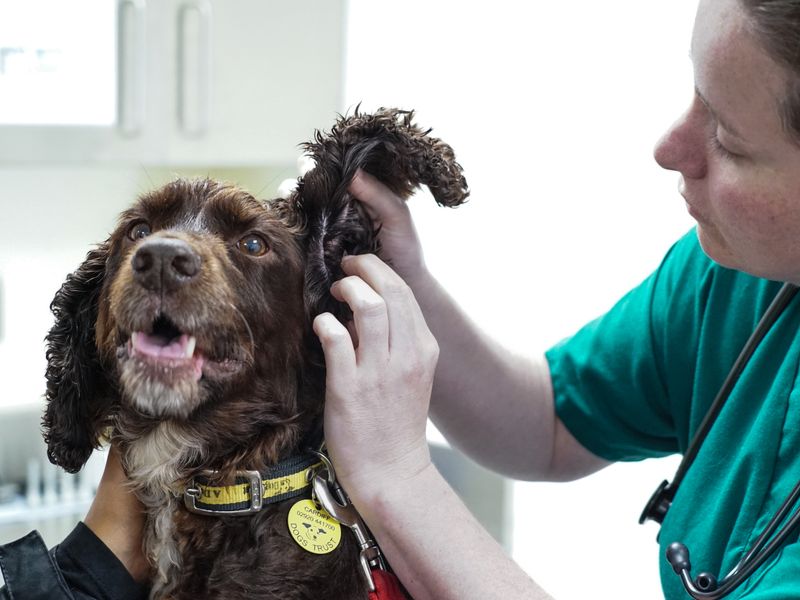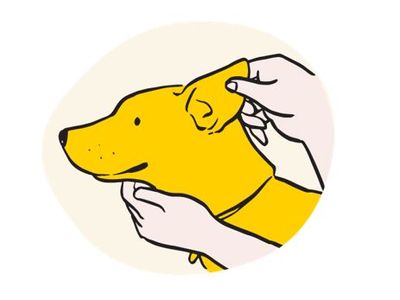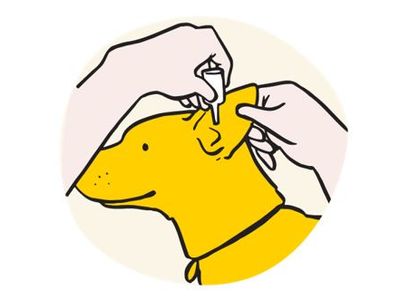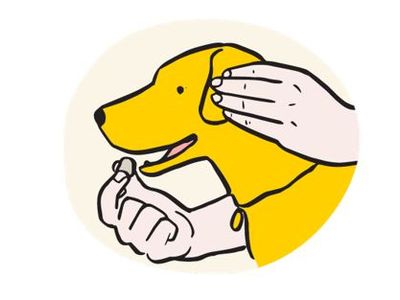How to clean your dog’s ears
Find out how to clean your dog’s ears with our expert advice.

Cleaning your dog's ears can be a normal part of grooming – but it's not always needed. Unnecessary ear cleaning may even create problems. So, it's important to know what's best for your furry friend.
Here’s our expert advice and step-by-step instructions on when, why, and how to clean your dog’s ears at home.
Can you safely clean your dog’s ears at home?
Yes, but only when advised by your vet. Trying to clean your pooch’s ears when there’s no need can actually create problems.
Every dog is different, so it’s important to always speak to your vet before attempting cleaning at home. Especially if you think your dog could have an ear infection.
If your vet has advised cleaning at home, do so in a way that makes your little pal feel relaxed and confident with the process.
If the cleaning isn’t urgent, try to build up to it gradually. Start by touching parts of their body where they’re familiar with being touched, and then work up to their ears.
Top tip: introducing a verbal cue, like ‘let me see,’ may help. Rewarding them with a treat will also build a positive association with the process.
How often should you clean your dog’s ears?
When it comes to hound hygiene, we know you’re all ears. But you should only clean your dog’s ears at home if recommended by your vet.
Each pooch is an individual, with their own hygiene needs. Some need regular ear-cleaning, while others require very little. Speak to your vet for advice on an ear-cleaning plan that suits your dog’s specific needs.
The anatomy of a dog’s ear
It’s important to be aware of how your dog’s ears are set up before attempting to clean them.
The canine ear canal is long with two parts: the vertical canal and the horizontal canal. At the end of the horizontal canal, the ear drum separates the external ear from the internal ear.
If your dog's ears are floppy, they may be covering the ear canal. This could block airflow and trap moisture, making infections more likely. Speak to your vet if you're concerned.
Remember, you should only attempt to clean your dog’s ears at home if specifically advised by your vet.
How to introduce your dog to ear care for the first time
When your dog is new to the ear care scene, they may feel a little nervous. So, it’s important to make sure they feel comfortable and relaxed throughout the process.
If it’s your furball’s first time, read our advice on how best to handle your dog. This will ensure you both feel happy and safe at all times throughout, and can keep those ears clean and tidy without a hitch.
How to clean your dog’s ears
The process of cleaning your dog’s ears at home may need adaptions for your dog’s individual needs. You can discuss this with your vet if they recommend at-home cleaning.
However, there are some steps that are considered good practice for most dogs.
Bear in mind the below steps are for ear cleaning, not medicated drops prescribed by a vet. Read our advice on how to administer ear or eye drops to your dog.
They should be introduced slowly and gradually to your dog where possible.
You’ll need:
- a clean towel
- damp cotton wool or pads
- an assistant, where possible
- plenty of treats
- dog-specific ear cleaner as recommended by your vet.
How to clean your dog’s ears: a step-by-step guide
Step 1
make sure your pooch is comfortable and relaxed – familiar surroundings may help with this – then gently lift their ear with your thumb and index finger
Step 2
look inside the ear, checking for redness, discharge, or bad smell. Tell your vet if you find lots of wax or any of the above symptoms
Step 3
gently wipe around the ear opening with some damp cotton wool to remove any dirt or excess wax
Step 4
squeeze some of the dog-friendly ear cleaner into their ear canal. Make sure not to insert the nozzle too deep
Step 5
massage the bottom of the ear to help move the ear cleaner through your dog’s ear canal and loosen any debris
Step 6
wipe away any excess ear-cleaner with damp cotton wool or a pad. Never use cotton buds as these can push wax or dirt deeper into the ear and could damage the ear drum
Step 7
if your dog shakes their head at this point, don’t worry. It can actually help loosen some of the debris and make it easier to clean away. Just make sure to shield your face if they do this
Step 8
repeat this process for their other ear if your vet has recommended you clean both
Step 9
reward your dog with their favourite treat. They’ve earned it!
If your dog’s ear-cleaning needs are urgent, there may not be time to ease them into the process. So, you may need to follow up with some positive ear interactions later. This will help your pooch feel relaxed and confident and come in handy for next time.
Treats can also be used to distract your dog if they find the process stressful. But be aware that focusing on a treat could cause them to be startled when their ear is touched.
Breed-specific things to consider
Some droopy-eared breeds of dog, like spaniels or beagles, may need more cleaning. Their ears get less airflow, so are at higher risk of infection.
Dogs who swim may also need more regular cleaning due to the risk of infection from water. Speak to your vet if any of these factors apply to your pooch.
Be aware that it may be difficult to spot anxiety in some dogs when cleaning their ears. It may be harder to spot tension in the faces of darker or more wrinkled dogs, for example. Make sure to always go at your dog's pace and take a break if they show any signs that they may be stressed.
Materials and substances
It may be tempting to use something from around the house to clean your dog’s ears, but you should avoid doing this. Ear-cleaners vary in strength. So, it’s important to use something appropriate for your individual dog.
Cleaning your dog’s ears should always be done using a specific ear cleaner as directed by your vet. Get in touch with your vet today if you think your dog might need their ears cleaning.
Can you clean your dog’s ears too much?
Yes. Cleaning your dog’s ears can cause irritation or infection if done too much or when it’s not needed. How often you do it depends on your individual pooch, their medical history, and lifestyle.
Your vet will be able to give you the best idea of how much ear-cleaning your pup needs.
The bottom line
Ear care is an essential part of your dog’s health and wellbeing. But speak to your vet if your think your furry pal could do with their ears cleaning. It’s not always needed and can even cause problems, so it should only be done if your vet advises so.
Dogs’ ears really are a wonder of the world, so let’s keep them happy and healthy!
Related articles






